Retrieval of Atmospheric Water Vapor Content in the Environment from AHI/H8 Using Both Physical and Random Forest Methods—A Case Study for Typhoon Maria (201808)
Abstract
1. Introduction
2. Data and Methods
2.1. Data
2.1.1. Forecasts
2.1.2. AHI Level1B
2.1.3. ERA5
2.1.4. Dropsonde
2.2. Methods
2.2.1. Maria Typhoon
2.2.2. RF-Based Algorithm
2.2.3. 1DVAR
2.3. Evaluation Criteria
3. Evaluations of RF-Based Algorithm
4. Comparisons of Retrievals between RF-Based and 1DVAR Algorithms
5. Summary and Discussion
- The GFS forecasts and the AHI measurements are both necessary information for moisture retrievals and provide supplemental value for each other;
- The accuracy of atmospheric water vapor retrievals using the RF-based algorithm with representative training dataset is enhanced when compared with the 1DVAR algorithm (e.g., with 35–45% improvement in this case);
- The retrievals can be conducted at full resolution in operation with high computational efficiency if using a machine learning-based algorithm instead, potentially for real-time or near real-time quantitative applications of high spatio-temporal resolution satellite measurements.
Author Contributions
Funding
Data Availability Statement
Acknowledgments
Conflicts of Interest
References
- Emanuel, K. Increasing destructiveness of tropical cyclones over the past 30 years. Nature 2005, 436, 686–688. [Google Scholar] [CrossRef]
- Elsner, J.B.; Kossin, J.P.; Jagger, T.H. The increasing intensity of the strongest tropical cyclones. Nature 2008, 455, 92–95. [Google Scholar] [CrossRef] [PubMed]
- Zhao, J.; Zhan, R.; Wang, Y. Different Responses of Tropical Cyclone Tracks Over the Western North Pacific and North Atlantic to Two Distinct Sea Surface Temperature Warming Patterns. Geophys. Res. Lett. 2020, 47, e2019GL086923. [Google Scholar] [CrossRef]
- Liu, H.; Tang, W.; Zhao, L. Analysis of helicity and moisture during a rainstorm effected by 0808 typhoon. Sci. Meteorol. Sin. 2010, 30, 344–350. [Google Scholar]
- Chen, X.; Zhang, J.; Li, C.; Cao, L. Study on the low_frequency environmental influences on the rapid intensification of typhoon “Lekima”. J. Meteorol. Sci. 2020, 40, 114–122. [Google Scholar]
- Lyu, Q.; Zhang, Y.; Jiang, H.; Zheng, H.; Chen, D.; Hu, Y. Precipitation evolution during the rapid intensification event of typhoon “Lekima” (1909). J. Meteorol. Sci. 2020, 40, 136–142. [Google Scholar]
- Li, Y.; Zhang, Z.; Gao, G.; Cong, C.; Li, R. Impacts of typhoon circulation on the water vapor transportation of remote precipitation. J. Mar. Meteorol. 2017, 37, 111–117. [Google Scholar]
- Bueh, C.; Zhuge, A.; Xie, Z.; Gao, Z.; Lin, D. Water Vapor Transportation Features and Key Synoptic-scale Systems of the 7.20 Rainstorm in Henan Province in 2021. Chin. J. Atmos. Sci. 2022, 46, 725–744. [Google Scholar]
- Li, Y.; Chen, L.; Wang, J. The Diagnostic analusis on the characteristics of large scale circulationcorresponding to the sustaining and decaying of tropical cyclone after it’s landfall. Acta Meteorol. Sin. 2004, 62, 167–179. [Google Scholar]
- Dai, Z.; Wu, H.; Jiang, Y.; Xia, M.; Zhu, X.; Qing, T. Characteristics of water vapor transport in precipitation difference between two landing typhoons of “Jelawat” and “Haiku”. J. Meteorol. Environ. 2018, 34, 16–24. [Google Scholar]
- Chen, Z.; Chen, L.; Li, Y. Diagnostic analysis of large-scale circulation features associated with strong and weak landfalling typhoon precipitation events. Acta Meteorol. Sin. 2009, 67, 840–850. [Google Scholar]
- Dee, D.P.; Uppala, S.M.; Simmons, A.J.; Berrisford, P.; Poli, P.; Kobayashi, S.; Andrae, U.; Balmaseda, M.A.; Balsamo, G.; Bauer, P.; et al. The ERA-Interim reanalysis: Configuration and performance of the data assimilation system. Q. J. R. Meteorol. Soc. 2011, 137, 553–597. [Google Scholar] [CrossRef]
- Chen, H.; Mao, Z.; Chen, J. A comparative analysis of climatological characteristics of landing typhoons with and without atmospheric river in recent 30 years in China. Acta Meteorol. Sin. 2020, 78, 745–760. [Google Scholar]
- Fujiwara, M.; Polavarapu, S.; Jackson, D. A proposal of the SPARC Reanalysis/Analysis Intercomparison Project. SPARC Newsl. 2012, 38, 14–17. [Google Scholar]
- Fujiwara, M.; Wright, J.S.; Manney, G.L.; Gray, L.J.; Anstey, J.; Birner, T.; Davis, S.; Gerber, E.P.; Harvey, V.L.; Hegglin, M.I.; et al. Introduction to the SPARC Reanalysis Intercomparison Project (S-RIP) and overview of the reanalysis systems. Atmos. Chem. Phys. 2017, 17, 1417–1452. [Google Scholar] [CrossRef]
- Hersbach, H.; Bell, B.; Berrisford, P.; Hirahara, S.; Horanyi, A.; Munoz-Sabater, J.; Nicolas, J.; Peubey, C.; Radu, R.; Schepers, D.; et al. The ERA5 global reanalysis. Q. J. R. Meteorol. Soc. 2020, 146, 1999–2049. [Google Scholar] [CrossRef]
- Bessho, K.; Date, K.; Hayashi, M.; Ikeda, A.; Imai, T.; Inoue, H.; Kumagai, Y.; Miyakawa, T.; Murata, H.; Ohno, T.; et al. An Introduction to Himawari-8/9-Japan’s New-Generation Geostationary Meteorological Satellites. J. Meteorol. Soc. Jpn. 2016, 94, 151–183. [Google Scholar] [CrossRef]
- Hu, X.; Huang, Y.; Lu, Q.; Zheng, J. Inversion of water vapor total using FY-3A near-infrared data. J. Appl. Meteorol. 2011, 22, 46–56. [Google Scholar]
- Schmit, T.J.; Li, J.; Lee, S.J.; Li, Z.; Dworak, R.; Lee, Y.-K.; Bowlan, M.; Gerth, J.; Martin, G.D.; Straka, W.; et al. Legacy Atmospheric Profiles and Derived Products From GOES-16: Validation and Applications. Earth Space Sci. 2019, 6, 1730–1748. [Google Scholar] [CrossRef]
- Yin, R.; Han, W.; Gao, Z.; Li, J. Impact of High Temporal Resolution FY-4A Geostationary Interferometric Infrared Sounder (GIIRS) Radiance Measurements on Typhoon Forecasts: Maria (2018) Case with GRAPES Global 4D-Var Assimilation System. Geophys. Res. Lett. 2021, 48, e2021GL093672. [Google Scholar] [CrossRef]
- Schmit, T.J.; Goodman, S.J.; Lindsey, D.T.; Rabin, R.M.; Bedka, K.M.; Gunshor, M.M.; Cintineo, J.L.; Velden, C.S.; Bachmeier, A.S.; Lindstrom, S.S.; et al. Geostationary Operational Environmental Satellite (GOES)-14 super rapid scan operations to prepare for GOES-R. J. Appl. Remote Sens. 2013, 7, 073462. [Google Scholar] [CrossRef]
- Schmit, T.J.; Goodman, S.J.; Gunshor, M.M.; Sieglaff, J.; Heidinger, A.K.; Bachmeier, A.S.; Lindstrom, S.S.; Terborg, A.; Feltz, J.; Bah, K.; et al. Rapid Refresh Information of Significant Events: Preparing Users for the Next Generation of Geostationary Operational Satellites. Bull. Am. Meteorol. Soc. 2015, 96, 561–576. [Google Scholar] [CrossRef]
- Lee, Y.-K.; Li, J.; Li, Z.; Schmit, T. Atmospheric temporal variations in the pre-landfall environment of typhoon Nangka (2015) observed by the Himawari-8 AHI. Asia-Pac. J. Atmos. Sci. 2017, 53, 431–443. [Google Scholar] [CrossRef]
- Di, D.; Li, J.; Li, Z.; Li, J.; Schmit, T.J.; Menzel, W.P. Can Current Hyperspectral Infrared Sounders Capture the Small Scale Atmospheric Water Vapor Spatial Variations? Geophys. Res. Lett. 2021, 48, e2021GL095825. [Google Scholar] [CrossRef]
- Xue, Y.; Li, J.; Li, Z.; Lu, R.; Gunshor, M.M.; Moeller, S.L.; Di, D.; Schmit, T.J. Assessment of Upper Tropospheric Water Vapor Monthly Variation in Reanalyses with Near-Global Homogenized 6.5-mu m Radiances from Geostationary Satellites. J. Geophys. Res.-Atmos. 2020, 125, e2020JD032695. [Google Scholar] [CrossRef]
- Jiang, X.; Li, J.; Li, Z.; Xue, Y.; Di, D.; Wang, P.; Li, J. Evaluation of Environmental Moisture from NWP Models with Measurements from Advanced Geostationary Satellite Imager-A Case Study. Remote Sens. 2020, 12, 670. [Google Scholar] [CrossRef]
- Schmit, T.J.; Li, J.; Gurka, J.J.; Goldberg, M.D.; Schrab, K.J.; Li, J.; Feltz, W.F. The GOES-R Advanced Baseline Imager and the Continuation of Current Sounder Products. J. Appl. Meteorol. Climatol. 2008, 47, 2696–2711. [Google Scholar] [CrossRef]
- Lee, Y.-K.; Li, Z.; Li, J.; Schmit, T.J. Evaluation of the GOES-R ABI LAP Retrieval Algorithm Using the GOES-13 Sounder. J. Atmos. Ocean. Technol. 2014, 31, 3–19. [Google Scholar] [CrossRef]
- Zhang, K.; Wu, C.; Li, J. Retrieval of Atmospheric Temperature and Moisture Vertical Profiles from Satellite Advanced Infrared Sounder Radiances with a New Regularization Parameter Selecting Method. J. Meteorol. Res. 2016, 30, 356–370. [Google Scholar] [CrossRef]
- Lee, Y.; Han, D.; Ahn, M.-H.; Im, J.; Lee, S.J. Retrieval of Total Precipitable Water from Himawari-8 AHI Data: A Comparison of Random Forest, Extreme Gradient Boosting, and Deep Neural Network. Remote Sens. 2019, 11, 1741. [Google Scholar] [CrossRef]
- Huang, Q.; Liang, W.L.; Huang, R. Comparative analysis of wind profile radar products and ERA5 reanalysis data. J. Meteorol. Res. Appl. 2021, 42, 83–88. [Google Scholar]
- Murata, H.; Takahashi, M.; Kosaka, Y. VIS and IR bands of Himawari-8/AHI compatible with those of MTSAT-2/Imager. MSC Tech. Note 2015, 60, 1–18. [Google Scholar]
- Li, J.; Schmidt, C.C.; Nelson, J.P. Estimation of Total Atmospheric Ozone from GOES Sounder Radiances with High Temporal Resolution. J. Atmos. Ocean. Technol. 2001, 18, 157–168. [Google Scholar] [CrossRef]
- Min, M.; Wu, C.; Li, C.; Liu, H.; Xu, N.; Wu, X.; Chen, L.; Wang, F.; Sun, F.; Qin, D.; et al. Developing the Science Product Algorithm Testbed for Chinese Next-Generation Geostationary Meteorological Satellites: Fengyun-4 Series. J. Meteorol. Res. 2017, 31, 708–719. [Google Scholar] [CrossRef]
- Wang, X.; Min, M.; Wang, F.; Guo, J.; Li, B.; Tang, S. Intercomparisons of Cloud Mask Products Among Fengyun-4A, Himawari-8, and MODIS. Ieee Trans. Geosci. Remote Sens. 2019, 57, 8827–8839. [Google Scholar] [CrossRef]
- Min, M.; Li, J.; Wang, F.; Liu, Z.; Menzel, W.P. Retrieval of cloud top properties from advanced geostationary satellite imager measurements based on machine learning algorithms. Remote Sens. Environ. 2020, 239, 111616. [Google Scholar] [CrossRef]
- Zhang, Y.; Li, J.; Li, Z.; Zheng, J.; Wu, D.; Zhao, H. FENGYUN-4A Advanced Geosynchronous Radiation Imager Layered Precipitable Water Vapor Products’ Comprehensive Evaluation Based on Quality Control System. Atmosphere 2022, 13, 290. [Google Scholar] [CrossRef]
- Davis, S.M.; Hegglin, M.I.; Fujiwara, M.; Dragani, R.; Harada, Y.; Kobayashi, C.; Long, C.; Manney, G.L.; Nash, E.R.; Potter, G.L.; et al. Assessment of upper tropospheric and stratospheric water vapor and ozone in reanalyses as part of S-RIP. Atmos. Chem. Phys. 2017, 17, 12743–12778. [Google Scholar] [CrossRef]
- Liu, C.-Y.; Chiu, C.-H.; Lin, P.-H.; Min, M. Comparison of Cloud-Top Property Retrievals from Advanced Himawari Imager, MODIS, CloudSat/CPR, CALIPSO/CALIOP, and Radiosonde. J. Geophys. Res. Atmos. 2020, 125, e2020JD032683. [Google Scholar] [CrossRef]
- Heng, J.; Yang, S.; Gong, Y.; Gu, J.; Liu, H. Characteristics of the convective bursts and their relationship with the rapid intensification of Super Typhoon Maria (2018). Atmos. Ocean. Sci. Lett. 2020, 13, 146–154. [Google Scholar] [CrossRef]
- Breiman, L. Random forests. Mach. Learn. 2001, 45, 5–32. [Google Scholar] [CrossRef]
- Turini, N.; Thies, B.; Bendix, J. Estimating High Spatio-Temporal Resolution Rainfall from MSG1 and GPM IMERG Based on Machine Learning: Case Study of Iran. Remote Sens. 2019, 11, 2307. [Google Scholar] [CrossRef]
- Kuehnlein, M.; Appelhans, T.; Thies, B.; Nauss, T. Precipitation Estimates from MSG SEVIRI Daytime, Nighttime, and Twilight Data with Random Forests. J. Appl. Meteorol. Climatol. 2014, 53, 2457–2480. [Google Scholar] [CrossRef]
- Zhang, H.; Tang, B. Remote sensing retrieval of total precipitable water under clear-sky atmosphere from FY-4A AGRI data by combining physical mechanism and random forest algorithm. J. Remote Sens. 2021, 25, 1836–1847. [Google Scholar] [CrossRef]
- Li, Z.; Li, J.; Menzel, W.P.; Schmit, T.J.; Nelson, J.P., III; Daniels, J.; Ackerman, S.A. GOES sounding improvement and applications to severe storm nowcasting. Geophys. Res. Lett. 2008, 35. Available online: https://www.webofscience.com/wos/woscc/full-record/WOS:000253063600007 (accessed on 18 December 2022).
- Li, J.; Schmit, T.J.; Jin, X.; Martin, G. GOES-R Advanced Baseline Imager (ABI) Algorithm Theoretical Basis Document for Legacy Atmospheric Moisture Profile, Legacy Atmospheric Temperature Profile, Total Precipitable Water, and Derived At-Mospheric Stability Indices; NOAA Nesdis Center for Satellite Applications and Research, 2010; Volume 106. Available online: http://www.goes-r.gov/products/ATBDs/baseline/Sounding_LAP_v2.0_no_color.pdf (accessed on 18 December 2022).
- Hannon, S.; Strow, L.L.; McMillan, W.W. Atmospheric infrared fast transmittance models: A comparison of two approaches. In Proceedings of the SPIE’s 1996 International Symposium on Optical Science, Engineering, and Instrumentation, Denver, CO, USA, 31 October 1996. [Google Scholar]
- Rodgers, C.D. Rereieval of atmospheric-temperature and composition from remote measurements of thermal-randiation. Rev. Geophys. 1976, 14, 609–624. [Google Scholar] [CrossRef]
- Li, J.; Nelson III, J.P.; Schmidt, C.C.; Schmit, T.J.; Menzel, W.P.; Seemann, S.; Eva, B. An approach to improvement temperature and moisture retrievals from the GOES Sounder measurements. In Proceedings of the 13th Conference on Satellite Meteorology and Oceanography, Norfolk, VA, USA, 19 September 2004. [Google Scholar]
- Li, J.; Wolf, W.W.; Menzel, W.P.; Zhang, W.J.; Huang, H.L.; Achtor, T.H. Global soundings of the atmosphere from ATOVS measurements: The algorithm and validation. J. Appl. Meteorol. 2000, 39, 1248–1268. [Google Scholar] [CrossRef]
- Li, J.; Paul Menzel, W.; Schmit, T.J.; Schmetz, J. Applications of geostationary hyperspectral infrared sounder observations—Progress, challenges, and future perspectives. Bull. Am. Meteorol. Soc. 2022, 103, E2733–E2755. [Google Scholar] [CrossRef]
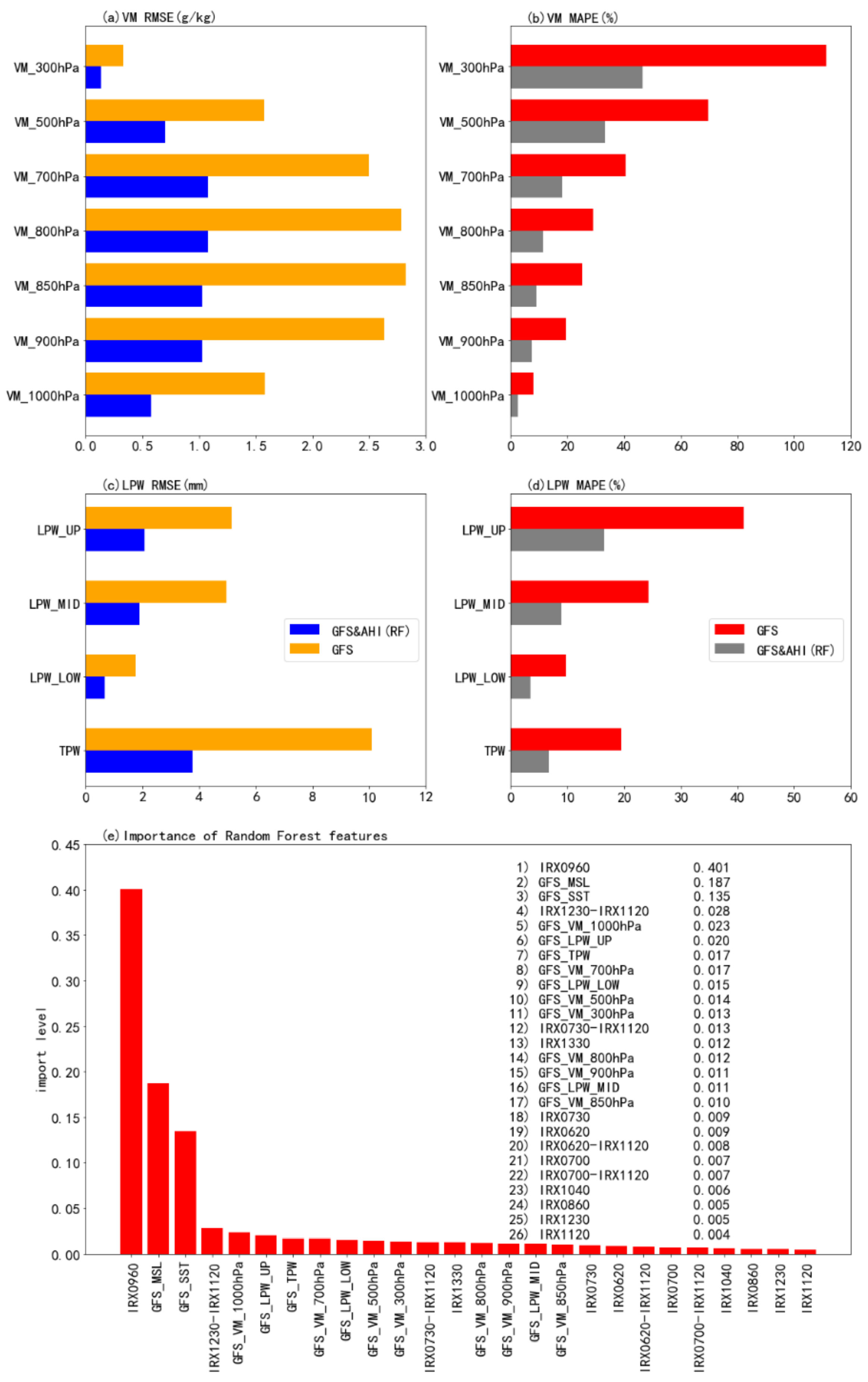
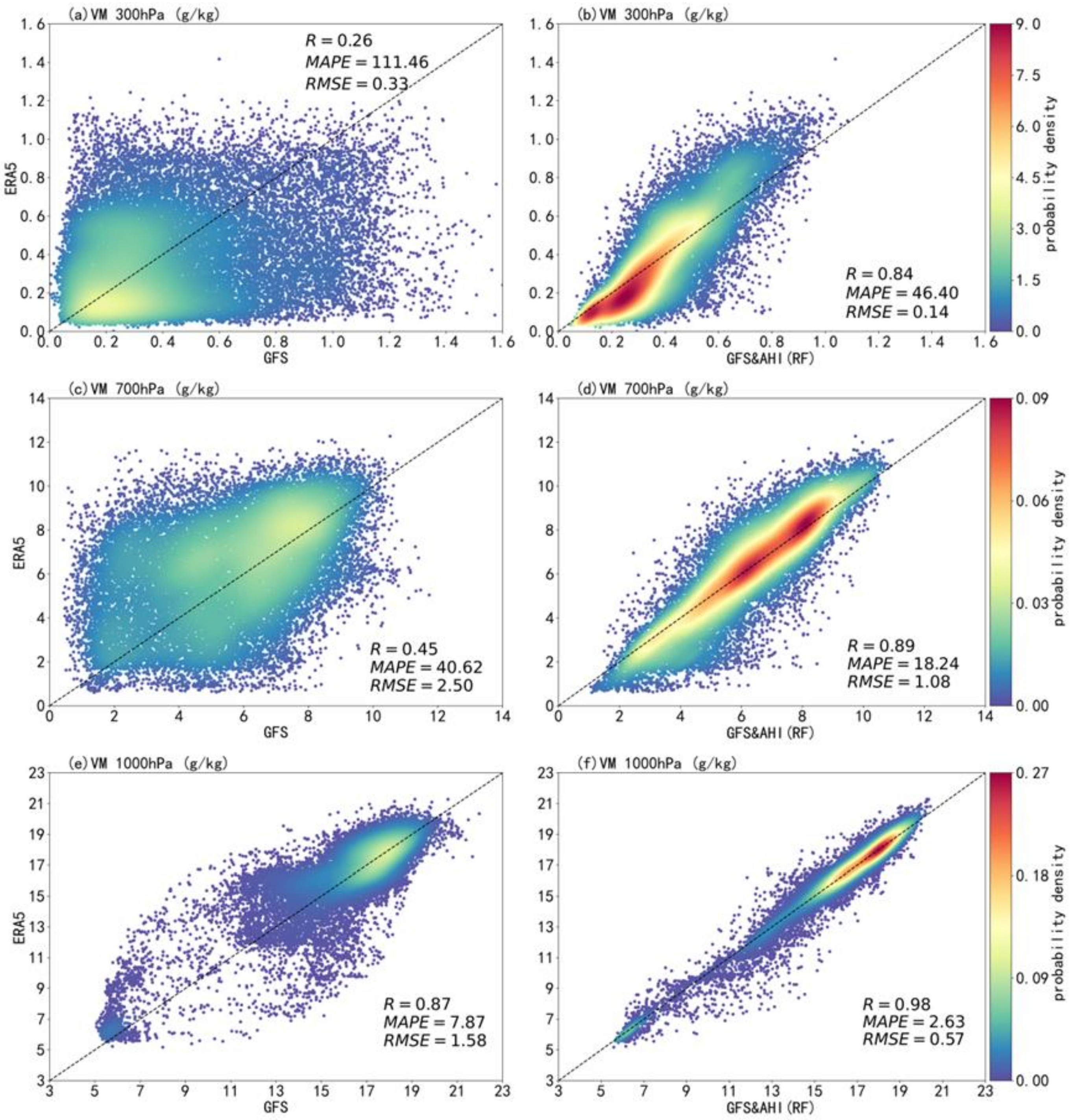
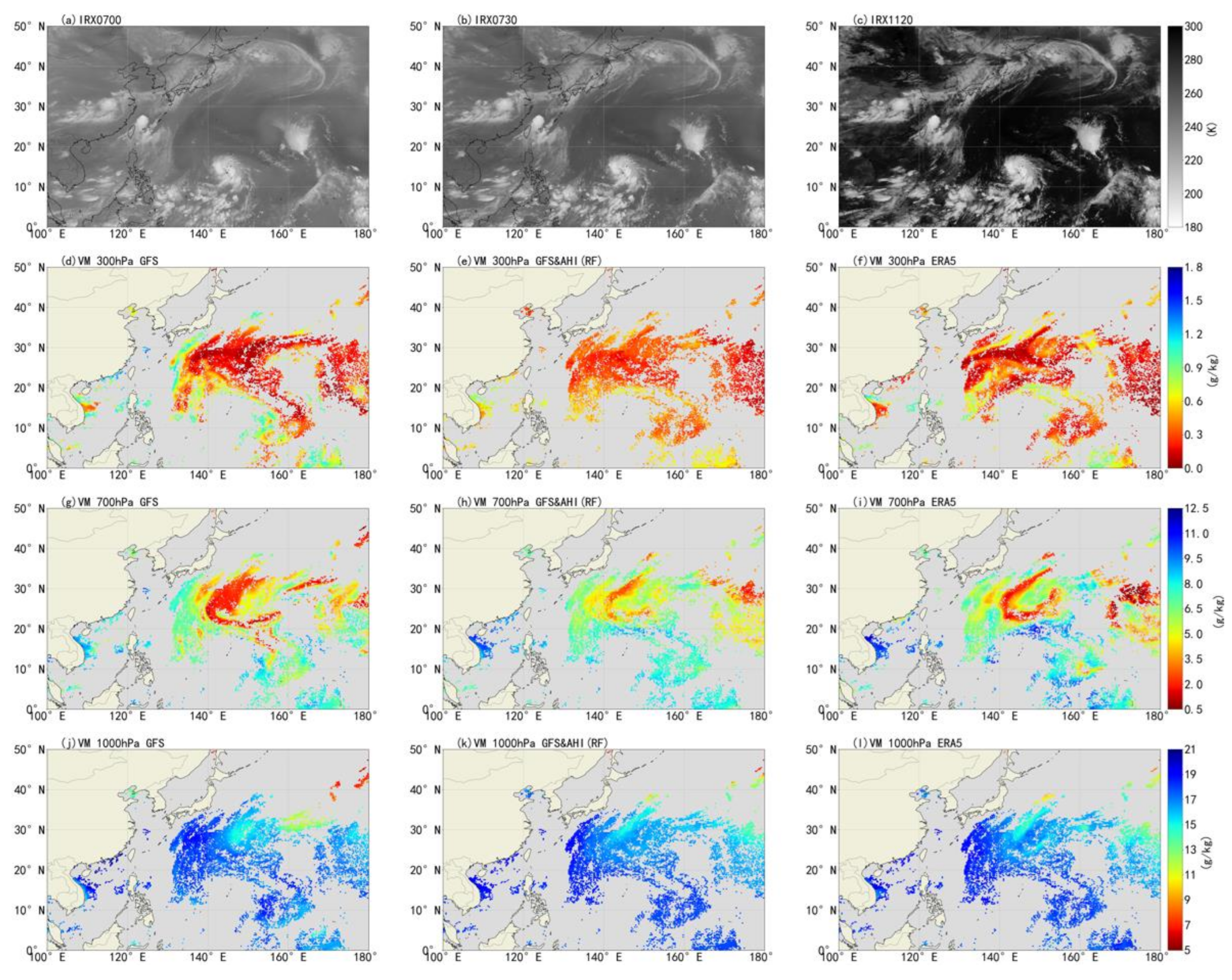
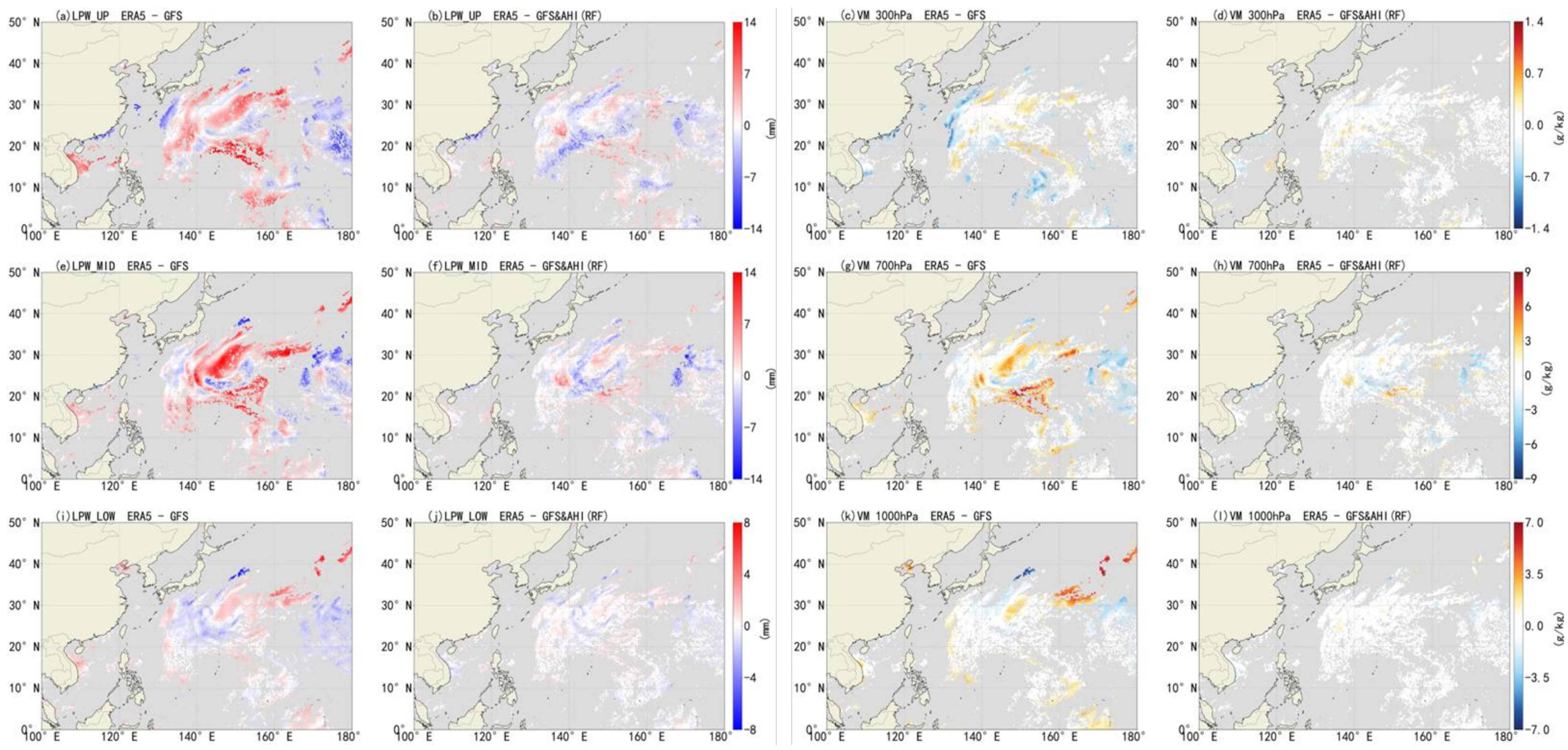
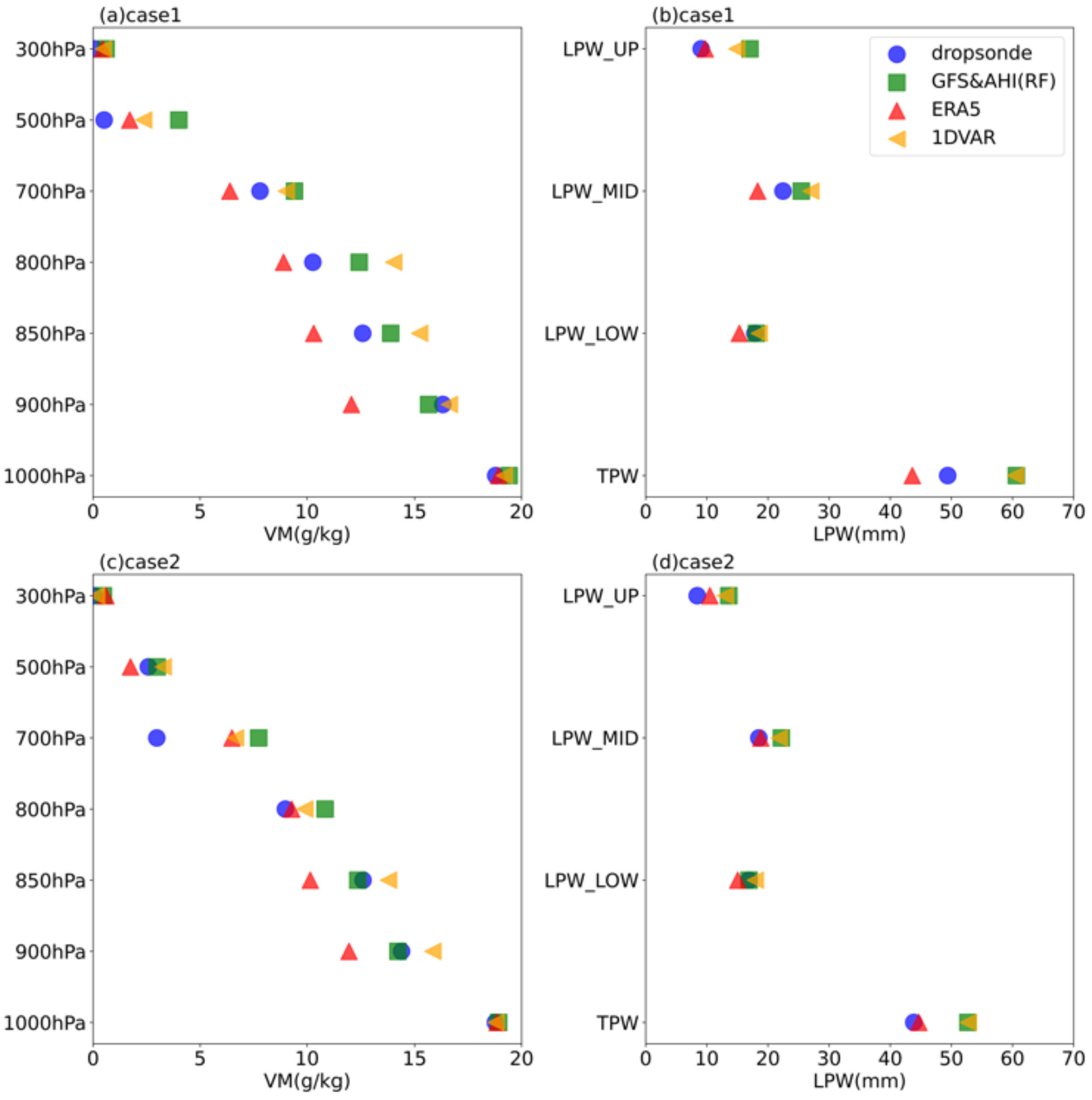
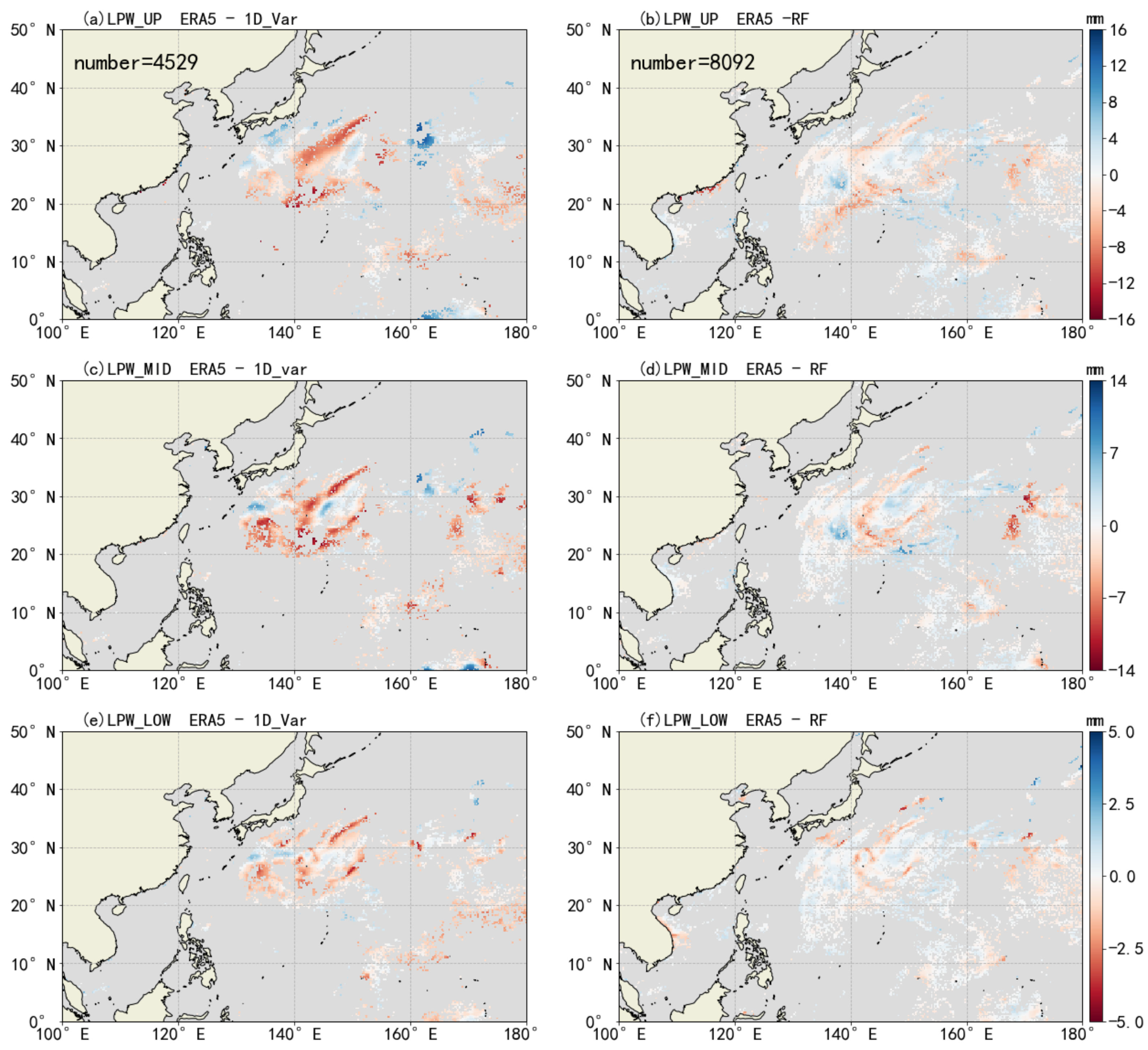
| Band Number | Central Wavelength (μm) | Resolution at Nadir (km) |
|---|---|---|
| 8 | 6.2 | 2.0 |
| 9 | 6.9 | |
| 10 | 7.3 | |
| 11 | 8.6 | |
| 12 | 9.6 | |
| 13 | 10.4 | |
| 14 | 11.2 | |
| 15 | 12.3 | |
| 16 | 13.3 |
| Variables | Information Provided by These Variables | ||
|---|---|---|---|
| Input | GFS | PRMSL_meansealevel (hPa) | Minimum sea level pressure |
| TMP_surface (K) | Sea surface temperature | ||
| VM (1000 hPa/900 hPa/850 hPa/ 800 hPa/700 hPa/500 hPa/300 hPa) (g/kg) | Water vapor specific humidity at specific atmospheric pressure levels | ||
| LPW (UP/MID/LOW) TPW (mm) | Layered precipitable water Total precipitable water | ||
| AHI | IRX0620 (K) | Brightness temperature of the AHI band 08 which provides upper tropospheric moisture information | |
| IRX0700 (K) | Brightness temperature of the AHI band 09 which provides middle to upper tropospheric moisture information | ||
| IRX0730 (K) | Brightness temperature of the AHI band 10 which provides low to middle tropospheric moisture information | ||
| IRX0860 (K) | Brightness temperature of the AHI band 11 | ||
| IRX0960 (K) | Brightness temperature of AHI band 12 | ||
| IRX1040 (K) | Brightness temperature of the AHI band 13 which provides SST information | ||
| IRX1120 (K) | Brightness temperature of the AHI band 14 which provides SST information | ||
| IRX1230 (K) | Brightness temperature of the AHI band 15 which provides boundary layer moisture information | ||
| IRX1330 (K) | Brightness temperature of the AHI band 16 which provides low level atmospheric temperature information | ||
| IRX0620-IRX1120 (K) | Brightness temperature difference | ||
| IRX0700-IRX1120 (K) | |||
| IRX0730-IRX1120 (K) | |||
| IRX1230-IRX1120 (K) | |||
| Output | ERA5 | MSL (hPa) | Minimum sea level pressure |
| SST (K) | Sea surface temperature | ||
| VM (1000 hPa/900 hPa/850 hPa/ 800 hPa/700 hPa/500 hPa/300 hPa) (g/kg) | Atmospheric water vapor mixing ratio at specific pressure levels | ||
| LPW(UP/MID/LOW) (mm) TPW (mm) | Layered precipitable water Total precipitable water |
| Super-Parameter | Definition | Number |
|---|---|---|
| 1. n_estimators | the number of trees | 300 |
| 2. max_features | the maximum number of predictors | “auto” |
| 3. max_depth | the maximum depth of the tree | 30 |
| Evaluation Indicators | Calculation Formulas | Range of Values | Optimum Value |
|---|---|---|---|
| RMSE | 0 | ||
| R | [–1, 1] | ||
| MAPE | 0 | ||
| MAE | 0 |
| RMSE | MAPE | MAE | R | |||||||||
|---|---|---|---|---|---|---|---|---|---|---|---|---|
| GFS | GFS+ AHI | Improvement (%) | GFS | GFS+ AHI | Improvement (%) | GFS | GFS+ AHI | Improvement (%) | GFS | GFS+ AHI | Improvement (%) | |
| MSL | 4.32 | 0.95 | 78.01 | 0.29 | 0.06 | 79.31 | 2.89 | 0.65 | 77.51 | 0.79 | 0.98 | 24.05 |
| SST | 1.21 | 0.45 | 62.81 | 0.27 | 0.10 | 62.96 | 0.81 | 0.29 | 64.20 | 0.98 | 0.99 | 1.02 |
| VM _1000 hPa | 1.58 | 0.57 | 63.92 | 7.87 | 2.63 | 66.58 | 1.14 | 0.39 | 65.79 | 0.87 | 0.98 | 12.64 |
| VM _900 hPa | 2.63 | 1.03 | 60.84 | 19.37 | 7.44 | 61.59 | 1.92 | 0.73 | 61.98 | 0.59 | 0.93 | 57.63 |
| VM _850 hPa | 2.82 | 1.02 | 63.83 | 25.25 | 9.01 | 64.32 | 2.11 | 0.72 | 65.88 | 0.53 | 0.93 | 75.47 |
| VM _800 hPa | 2.78 | 1.08 | 61.15 | 28.97 | 11.30 | 60.99 | 2.20 | 0.78 | 64.55 | 0.51 | 0.91 | 78.43 |
| VM _700 hPa | 2.50 | 1.08 | 56.80 | 40.62 | 18.24 | 55.10 | 1.98 | 0.79 | 60.10 | 0.45 | 0.89 | 97.78 |
| VM _500 hPa | 1.58 | 0.70 | 55.70 | 69.83 | 33.30 | 52.32 | 1.24 | 0.52 | 58.06 | 0.40 | 0.89 | 122.5 |
| VM _300 hPa | 0.33 | 0.14 | 57.58 | 111.46 | 46.40 | 58.37 | 0.26 | 0.10 | 61.54 | 0.26 | 0.94 | 261.54 |
| TPW | 10.10 | 3.76 | 62.77 | 19.47 | 6.66 | 65.79 | 7.99 | 2.64 | 66.96 | 0.64 | 0.94 | 46.88 |
| LPW_LOW | 1.76 | 0.66 | 62.50 | 9.68 | 3.45 | 64.36 | 1.25 | 0.45 | 64.00 | 0.82 | 0.97 | 18.29 |
| LPW_MID | 4.96 | 1.89 | 61.90 | 24.35 | 8.97 | 63.16 | 3.86 | 1.35 | 65.03 | 0.56 | 0.93 | 66.07 |
| LPW_UP | 5.14 | 2.07 | 59.73 | 41.11 | 16.54 | 59.77 | 4.07 | 1.49 | 63.39 | 0.48 | 0.91 | 89.58 |
| RMSE (Unit: mm) | MAPE (Unit: %) | MAE (Unit: mm) | R | |||||||||
|---|---|---|---|---|---|---|---|---|---|---|---|---|
| 1DVAR | RF | Improvement (%) | 1DVAR | RF | Improvement (%) | 1DVAR | RF | Improvement (%) | 1DVAR | RF | Improvement (%) | |
| Clear (0–10%) | 1.17 | 0.70 | 40.17 | 6.24 | 3.44 | 44.87 | 0.92 | 0.49 | 46.74 | 0.71 | 0.86 | 17.44 |
| Partly Cloudy (10–30%) | 1.00 | 061 | 39.00 | 5.33 | 2.92 | 45.22 | 0.81 | 0.42 | 48.45 | 0.82 | 0.88 | 9.00 |
| Cloudy (30–70%) | 1.23 | 0.73 | 40.65 | 6.64 | 3.81 | 42.62 | 0.97 | 0.55 | 43.30 | 0.77 | 0.86 | 10.46 |
| Overcast (70–100%) | 1.11 | 0.71 | 36.04 | 6.18 | 3.53 | 42.88 | 0.90 | 0.50 | 44.44 | 0.72 | 0.85 | 15.29 |
Disclaimer/Publisher’s Note: The statements, opinions and data contained in all publications are solely those of the individual author(s) and contributor(s) and not of MDPI and/or the editor(s). MDPI and/or the editor(s) disclaim responsibility for any injury to people or property resulting from any ideas, methods, instructions or products referred to in the content. |
© 2023 by the authors. Licensee MDPI, Basel, Switzerland. This article is an open access article distributed under the terms and conditions of the Creative Commons Attribution (CC BY) license (https://creativecommons.org/licenses/by/4.0/).
Share and Cite
Zhu, L.; Zhou, R.; Di, D.; Bai, W.; Liu, Z. Retrieval of Atmospheric Water Vapor Content in the Environment from AHI/H8 Using Both Physical and Random Forest Methods—A Case Study for Typhoon Maria (201808). Remote Sens. 2023, 15, 498. https://doi.org/10.3390/rs15020498
Zhu L, Zhou R, Di D, Bai W, Liu Z. Retrieval of Atmospheric Water Vapor Content in the Environment from AHI/H8 Using Both Physical and Random Forest Methods—A Case Study for Typhoon Maria (201808). Remote Sensing. 2023; 15(2):498. https://doi.org/10.3390/rs15020498
Chicago/Turabian StyleZhu, Linyan, Ronglian Zhou, Di Di, Wenguang Bai, and Zijing Liu. 2023. "Retrieval of Atmospheric Water Vapor Content in the Environment from AHI/H8 Using Both Physical and Random Forest Methods—A Case Study for Typhoon Maria (201808)" Remote Sensing 15, no. 2: 498. https://doi.org/10.3390/rs15020498
APA StyleZhu, L., Zhou, R., Di, D., Bai, W., & Liu, Z. (2023). Retrieval of Atmospheric Water Vapor Content in the Environment from AHI/H8 Using Both Physical and Random Forest Methods—A Case Study for Typhoon Maria (201808). Remote Sensing, 15(2), 498. https://doi.org/10.3390/rs15020498






